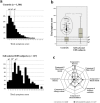Development and evaluation of an electromagnetic hypersensitivity questionnaire for Japanese people
- PMID: 27324106
- PMCID: PMC5094565
- DOI: 10.1002/bem.21987
Development and evaluation of an electromagnetic hypersensitivity questionnaire for Japanese people
Abstract
The purpose of the present study was to evaluate the validity and reliability of a Japanese version of an electromagnetic hypersensitivity (EHS) questionnaire, originally developed by Eltiti et al. in the United Kingdom. Using this Japanese EHS questionnaire, surveys were conducted on 1306 controls and 127 self-selected EHS subjects in Japan. Principal component analysis of controls revealed eight principal symptom groups, namely, nervous, skin-related, head-related, auditory and vestibular, musculoskeletal, allergy-related, sensory, and heart/chest-related. The reliability of the Japanese EHS questionnaire was confirmed by high to moderate intraclass correlation coefficients in a test-retest analysis, and high Cronbach's α coefficients (0.853-0.953) from each subscale. A comparison of scores of each subscale between self-selected EHS subjects and age- and sex-matched controls using bivariate logistic regression analysis, Mann-Whitney U- and χ(2) tests, verified the validity of the questionnaire. This study demonstrated that the Japanese EHS questionnaire is reliable and valid, and can be used for surveillance of EHS individuals in Japan. Furthermore, based on multiple logistic regression and receiver operating characteristic analyses, we propose specific preliminary criteria for screening EHS individuals in Japan. Bioelectromagnetics. 37:353-372, 2016. © 2016 The Authors. Bioelectromagnetics Published by Wiley Periodicals, Inc.
Keywords: EHS screening tool; allergy symptoms; electromagnetic fields; idiopathic environmental intolerance; multiple chemical sensitivities.
© 2016 The Authors. Bioelectromagnetics Published by Wiley Periodicals, Inc.
Figures



References
-
- Abdel‐Rassoul G, El‐Fateh OA, Salem AM, Michael A, Farahat F, El‐Batanouny M, Salem E. 2007. Neurobehavioral effects among inhabitants around mobile phone base stations. Neuro Toxicology 28:434–440. - PubMed
-
- Baliatsas C, Kamp I, Van Bolte J, Schipper M, Yzermans J, Lebret E. 2012. Non‐specific physical symptoms and electromagnetic field exposure in the general population: Can we get more specific? A systematic review. Environ Internatl 41:15–28. - PubMed
-
- Berg‐Beckhoff G, Blettner M, Kowall B, Breckenlamp J, Schlehofer B, Bronkessel C, Reis U, Potthoff P, Schüz J. 2009. Mobile phone base stations and adverse health effects: Phase 2 of a cross‐sectional study with measured radio frequency electromagnetic fields. Occup Environ Med 66:124–130. - PubMed
-
- Blettner M, Schlehofer B, Breckenkamp J, Kowall B, Schmiedel S, Reis U, Potthoff P, Schüz J, Berg‐Beckhoff G. 2009. Mobile phone base stations and adverse health effects: Phase 1 of a population‐based, cross‐sectional study in Germany. Occup Environ Med 66:118–123. - PubMed
-
- COST: European Cooperation in Science and Technology: Factsheet. 2011. Idiopathic environmental intolerance attributed to electromagnetic fields (IEI‐EMF) or ‘electromagnetic hypersensitivity’. Available from: http://www.mobileresearch.ethz.ch/fileadmin/redaktion/public/downloads/p... [last accessed 18 January 2013].
Publication types
MeSH terms
LinkOut - more resources
Full Text Sources
Other Literature Sources
Medical

